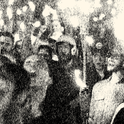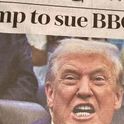North Korea is now, unquestionably, a nuclear power. Over the past year, under the leadership of its dictator, Kim Jong-un, it has completed a decades-long effort to acquire the ability to deliver a thermonuclear weapon against major cities in the United States. It has tested a new long-range ballistic missile, designed and produced domestically, that can strike targets thousands of miles away, as well as a thermonuclear weapon—with 10 times the destructive force of the bomb that destroyed Nagasaki—to arm it. This military build-up has been matched with tough talk from Kim.
The US has responded in its own way by adding bombers to military exercises with South Korea and deploying new missile defences. President Donald Trump has taken to Twitter with missives that often exceed the bombast of Kim’s own statements. Trump has talked of unleashing “fire and fury like the world has never seen,” used a speech at the United Nations to deride Kim as “Rocket Man,” and threatened to “totally destroy North Korea.” The spectre of nuclear war seems to haunt us once again, as the world’s only superpower finds itself threatened by one of its poorest, most isolated nations.
This is a new experience for most Americans. The US has not experienced the emergence of an overtly hostile nuclear-armed power since the chilliest moments of the Cold War. In the meantime, Americans have forgotten the cold, unremitting logic of the balance of terror. The Soviet Union was stagnant and wretched, but held half of Europe in chains and America at bay for 40 years. That is the awful power of nuclear weapons, something seemingly forgotten in the aftermath of America’s Cold War victory. The unfamiliar situation has resulted in a kind of a shock. How did this happen?
The very question though is absurd. No great power has maintained an indefinite dominion, let alone the invulnerability that is currently taken for granted in Washington. The assumption that the US would remain apart from a troubled world where it could intervene with might and impunity is itself the aberration. The shock of 2017 lies in the delusions of 1991.
That was a year of triumph for the US. In February, the American military swiftly prevailed over Iraqi forces in the first Gulf War, liberating Kuwait while destroying what was then the world’s fourth largest army and, along with it, the post-Vietnam reluctance to deploy ground-troops abroad. Then, in August, a coup against the Soviet leader Mikhail Gorbachev failed, leading to the rapid disintegration of the Soviet Union. Within a span of months, the US had disposed of the painful legacy of Vietnam and watched the threat posed by tens of thousands of Soviet nuclear weapons seemingly vanish. In the midst of this exuberance, General Colin Powell—then the Chairman of the US Joint Chiefs of Staff—gave a celebratory interview. “I’m running out of demons. I’m running out of villains,” Powell told the Army Times. “I’m down to Castro and Kim Il-sung.”
A quarter of a century later, the mood is rather less jubilant in an America beset by demons and villains, at home and abroad. The return to Iraq in 2003 was an unmitigated disaster—it remains a quagmire after more than a decade of US involvement, with plenty of echoes of Vietnam. Meanwhile Vladimir Putin’s Russia has resurrected distinctly Soviet attitudes and behaviours on the world stage, ignoring arms control agreements it sees as unfair, and modernising its nuclear forces. As for Castro and Kim Il-sung, each managed the process of leadership succession, bequeathing immediate family members the firm control of Cuba and North Korea respectively. The Obama administration made its peace with Cuba. But the threat from North Korea, now ruled by Kim Il-sung’s grandson, has only increased.
The idea that North Korea might be able to strike the US with nuclear weapons once struck many as unimaginable. It seemed impossible that this ridiculous country, led in recent years by a “pygmy” and then a “fat kid” should be able to threaten to rain death and destruction on prosperous American cities.
And for that reason—because it seemed impossible—many Americans simply could not anticipate the approaching era of vulnerability. Not merely because Americans underestimated the North Koreans—although their own troubled racial attitudes played a part—but because Americans’ privileged national myths about exceptionalism and military might over the evidence that was plain for all to see. The sudden realisation that North Korea can, in fact, pose a threat to the US has produced a kind of panic. What the current situation requires is not merely rethinking American policies toward the Korean peninsula, but thinking differently about America’s place in the world.
Triumph
Those who had worked on the Manhattan Project to develop the atomic bomb during the Second World War, saw clearly that nuclear weapons create a shared danger that compelled us to work with even those states considered enemies. Robert Oppenheimer, the director of the laboratory that designed the bombs, tried to capture this shared fate when he likened the US and Soviet Union to a pair of scorpions in a bottle, “each capable of killing the other, but only at the risk of his own life.” Many Soviets noticed this too. It was a Soviet weaponeer who reflected ruefully that the two countries were “doomed” to co-operate.But there were always many other Americans who couldn’t reconcile themselves to the idea that the US lived in a state of vulnerability to Soviet nuclear weapons. In the 1960s, those Americans had pushed for civil defence measures. By the 1980s, the focus of their efforts had turned to preventative missile defences. They imagined what came to be labelled “Star Wars” somehow protecting America from the world in the same way that the oceans had done in earlier times.
This school of thought was often caricatured as hopelessly naïve, but 1991 changed all that. The war in the Gulf seemed to validate the wildest hopes of the technological fantasists, as Israel had—apparently—successfully defended itself against missile attack. And the collapse of the Soviet Union seemed to signal that the cost of keeping up with American technical advancements would bankrupt any adversary. That the Israeli missile defences had not really worked would not be known until later. And the myriad reasons for the collapse of the Soviet Union were too complicated for the casual observers. Many Americans instead drew the simplistic, and beguiling, conclusion that there was a technological escape from Oppenheimer’s bottle.
At the same time, however, hostile military and political leaders around the world were drawing different conclusions about their vulnerability to American power and the right routes of escape. Plenty of observers around the world agreed with the view, usually ascribed to an Indian general called Sundarji, that the lesson was simple: “Never fight the US without nuclear weapons.”
Kim Il-sung did not disagree. Long before the end of the Cold War North Korea had expressed an interest in nuclear weapons—it dated back to the 1960s. South Korea, too, started a nuclear weapons programme during its period of military dictatorship. But while the South democratised and focused on building its economy, Pyongyang pressed on—successfully constructing a gas-graphite reactor to produce plutonium for nuclear weapons in the 1980s, along with a “radio-chemical” plant to recover that plutonium. The US and other countries pressured North Korea to join the Nuclear Non-Proliferation Treaty (NPT) as a “non-nuclear weapons state” and to accept inspections by the International Atomic Energy Agency (IAEA). But in 1992 and 1993 inspectors from the IAEA uncovered a series of inconsistencies and falsehoods in North Korea’s declarations about its past nuclear activities, prompting a crisis—one that deepened once North Korea unloaded a batch of fuel rods containing enough plutonium for several nuclear weapons.
North Korea and the Clinton administration attempted to defuse the stand-off with a diplomatic agreement signed in 1994 called the Agreed Framework. Under its terms, North Korea froze its known facilities for producing plutonium for nuclear weapons in exchange for the provision of energy assistance, including a pair of light-water nuclear reactors, and promises of improved relations. The North Koreans, isolated after the loss of their Soviet patron and unsure that their nuclear programme would ultimately succeed, seem to have calculated that the Agreed Framework removed the risk of war and offered a path to a less hostile relationship with the US.
Many of those who believed that the US could muscle its way out of danger were appalled by the diplomatic settlement which appeared to reward North Korea for foregoing nuclear weapons. Senator John McCain compared the agreement unfavourably to Munich, saying: “If it quacks like a duck and walks like a duck, it’s appeasement.” In the triumphalist 1990s, many struggled to understand why the US should compromise with or compensate a small and bizarre country like North Korea.
Fear
Despite that the fact that George W Bush had criticised the nuclear agreement with North Korea during his 2000 campaign for the presidency, the initial indications were that his administration would give the agreement time to work. Powell, by then the US Secretary of State, even let slip that Bush intended to “pick up where President Clinton left off.” But then came 11th September 2001.Perhaps the single most powerful impulse stirred that day was to restore America’s supposed lost invulnerability. The US did not invade Iraq because its leaders falsely believed that Saddam Hussein had perpetrated the attacks, but because for many Americans the lesson of 9/11 was that the country had not tried hard enough to eliminate threats around the world. Dick Cheney, Bush’s Vice President, reportedly explained what he called the “one per cent doctrine,” saying that if there is “a one per cent chance” that a threat to the US was real, “we have to treat it as a certainty in terms of our response.”
The 9/11 attack and preparations for the Iraq war delayed any effort to engage with North Korea. Before the Bush administration got around picking up where Clinton had left off, American intelligence agencies discovered that Pyongyang was attempting to open a new route to build nuclear weapons.
Clinton administration officials had known for some time about North Korea’s interest in uranium enrichment, including its ties to a Pakistani scientist called Abdul Qadeer Khan. The very existence of Khan should have been a warning to those who believed the US could enjoy an indefinite period of invincibility. Khan had been running what was later called a “nuclear Walmart”—a network of suppliers that helped countries build centrifuges to enrich uranium for nuclear weapons. Khan’s clients included Libya, Iran and North Korea. But the Clinton administration had believed that the problem was a long-term concern—a serious problem, but one of many that could be dealt with in time, through diplomacy.
Hawks in the Bush administration, though, took a very different approach, seeing the intelligence as validation that diplomacy had failed, and as an opportunity to walk away from the Agreed Framework as the real hardliners had always hoped to do. The Bush administration may have been emboldened by the conviction that North Korea would soon collapse. Not only was it a relic of a now dead Soviet empire, but American pundits were at the very same moment predicting that Operation Iraqi Freedom would be a “cakewalk” and that the United States “did not negotiate with evil.” Bush walked away from the Agreed Framework. But North Korea did not collapse. Within three years, it had tested its first nuclear weapon.
Not long after North Korea’s nuclear test in October 2006, a perhaps humbled Bush performed a U-turn and began to explore the possibility of a negotiated solution to North Korea’s nuclear programmes. But there was a problem: how to persuade Pyongyang that if they were to abandon their nuclear weapons they would not be as vulnerable as Saddam had been. Condoleezza Rice, having by then replaced Powell as Secretary of State, even considered using Muammar Gaddafi’s Libya—whom the US had recently made its temporary peace with—as a backchannel for negotiations. Only North Korea’s concerns about the intrusiveness of the verification provisions prevented the Bush administration striking a deal. The Obama administration was similarly thwarted six years later. In 2012 it negotiated the ill-fated Leap Day Deal—a pair of unilateral statements to freeze certain activities in advance of negotiations that might take place. But it collapsed within days when it became obvious that the unilateral statements contained significant disparities, particularly North Korea’s insistence on its right to launch a satellite into space to celebrate the centenary of Kim Il-sung’s birth.
Each agreement failed for different reasons, yet there was a commonality to all the failures to find some agreement. North Korea was moving forward, making progress year after year. US officials were trying to find a way back to that triumphal moment in the earlier 1990s when Pyongyang did not have nuclear weapons. But that moment was gone. Nostalgia clouded what should have been a cold-eyed recognition that North Korea’s leverage was increasing steadily. To the extent that Washington made concessions, they were too little, too late.
And, of course, the North Koreans had less and less reason to feel confident in the promises of the US. Armed groups rose up against Gaddafi in 2011. Nato, led by the US, United Kingdom and France, used airpower to support those rebels seeking to oust Gaddafi. During this period, John Bolton, the neoconservative who had been a senior State Department official when Bush struck the deal with Libya, pointedly called for the US to assassinate Gaddafi, arguing that the disarmament deal with the Libyan leader had never been “a get-out-of-jail-free card in perpetuity.” When Gaddafi met a grisly end at the hands of captors, the North Koreans noticed. His fate is a theme that North Korea’s state news agency, the KCNA, has returned to, again and again. “Libya scrapped its decades-old nuclear programme, pinning hope on big powers and yielding to their pressure and appeasement, and abandoned its nuclear deterrence,” it wrote. “In the end it fell victim to aggression.”
Acceptance
In the years after the humiliation of the Leap Day Deal, the Obama administration settled into a policy widely derided as “strategic patience” after a phrase coined by Hillary Clinton. Obama administration officials hated the term, but it fairly captured their approach.There was an obvious reluctance to engage with the North Koreans. They were prone to tendentious interpretations of agreements to the point of outright cheating. And the deplorable human rights situation in North Korea meant that any engagement would come at a high political cost. Who wants to have a lavish state dinner with the leader of a starving country that routinely requires food aid?
The North Korean regime never made it easy. When an official visited Washington in 2000, he attended his meetings at the State Department in a business suit. When he met President Clinton in the afternoon, however, he arrived in full military uniform, complete with a medal from the Korean War. Clinton’s face in the resulting photograph is a study in muted frustration. The North Koreans seemed to delight in making everything as difficult as possible. It is easy to see why neither Bush nor Obama were eager to take extraordinary risks in negotiating with Pyongyang.
And yet, during this time, Pyongyang’s nuclear and missile capabilities continued to grow. North Korea conducted five nuclear tests during the Bush and Obama years, stockpiled plutonium for a growing nuclear arsenal, and completed the development of a rocket capable of launching a satellite into space.
Over the same period, the North Koreans repeatedly emphasised that their goal was the development of a nuclear arsenal that could hold the US at bay. They even released a four-hour propaganda film expounding on the theme that North Korea’s nuclear and missile capabilities were essential to its survival. The film has a happy ending of sorts, at least if you’re North Korean: Bill Clinton travels to Pyongyang to officially recognise North Korea as a nuclear-armed power.
Few Americans would have imagined that the real-life version of events would end there too. Most Americans told themselves North Korea would collapse. Or that North Korea’s scientists and engineers would never be able to master nuclear weapons or ballistic missiles. Or that if they did, the warheads would be too large for the missile or might burn up upon re-entering the earth’s atmosphere. That sanctions would stop them or bring this Kim or that to heel. That missile defences could shoot them down. By the end, US officials were hinting that there was a secret programme of sabotage that would put off the day of reckoning. Americans imagined every reason to keep alive the fantasy that it was still 1991.
The problem is that few American politicians or officials had the slightest idea how to make that happen. And almost no one was unwilling to lower expectations.
The US must now accept that North Korea has nuclear weapons and will not, for the foreseeable future, abandon them. This does not mean granting some form of legal recognition for North Korea’s nuclear status, but Washington must accept that it has interests beyond simple denuclearisation. That it cares about deterring North Korea from attacking its neighbours. That it cares about discouraging North Korea from selling nuclear and missile technologies. That it cares about addressing the dreadful human rights situation in North Korea. And that it cares about restraining those in Japan and especially South Korea who see the development of their own nuclear weapons as a route to security. And above all else, that it has an interest in avoiding a nuclear war on the Korean Peninsula—an interest shared with North Korea.
It is not very popular, in America, to observe that such a mighty power shares some interests with a miserable tyranny like North Korea. And yet that is what nuclear deterrence means. It was not a very popular thing to admit about the Soviet Union or Mao Zedong’s China, either. And yet, if the US does not admit it, the current cycle of steady North Korean technical advancements followed by exchanges of threats and increasingly provocative demonstrations will remain. North Korea has now flown long-range missiles over Japan and threatened to strike the waters around Guam. The nightmare scenario is that North Korea might arm a missile with a live nuclear weapon and test it in the ocean—something the US, Soviet Union and China did in the 1960s.
If Washington wants to depart from this cycle, it is time to talk to the North Koreans—not about denuclearisation, but about other ways to calm fears and improve relations. The two antagonists, along with South Korea and Japan, need to find a way to reduce tension on the Korean Peninsula. This may include a freeze on the testing of both nuclear and conventional missiles in exchange for limits on US and South Korean military exercises. They also need to think about crisis communications, such as hotlines, and transparency measures related to military activities. And ultimately, they need to think about replacing the armistice, under which the US and North Korea remain at war, with a peace treaty. If all this sounds like a victory of North Korea’s campaign to develop thermonuclear weapons that can strike America, well, it is. China’s first nuclear test was in October 1964. By February 1972, Richard Nixon had famously gone to China. By 1979, the US had diplomatic relations with China and Deng Xiaoping had made a state visit to America. Nuclear weapons confer power and status, whether we like it or not.
If hosting Kim Jong-un, the dictator of a starving nation, for a sumptuous state dinner seems hard to accept, that is the triumphalism of 1991 clouding judgment. In the insecurity of 2017, Americans have to accept that they do not have the power to simply topple dictators who abuse human rights or threaten their neighbours. If one looks closely, it becomes clear that it was the illusion of omnipotence, born in a moment of triumph and sustained by desperate efforts to extend it, that brought us a nuclear-armed North Korea. Powell could not see the threats of the future because he was looking in the wrong place. The villains that beset America and the demons that led Washington astray, were never to be found in Cuba or North Korea. They were to be found at home, within America itself.












